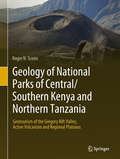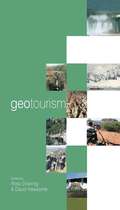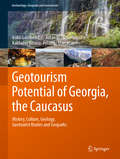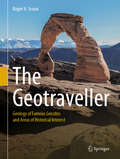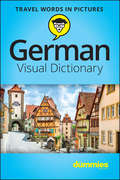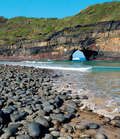- Table View
- List View
Geology of National Parks of Central/Southern Kenya and Northern Tanzania: Geotourism of the Gregory Rift Valley, Active Volcanism and Regional Plateaus
by Roger N. ScoonThis book describes the interrelationship between the spectacular geology of an area of East Africa that includes a branch of the rift valley, as well as giant freestanding ice-capped mountains and extraordinarily toxic, alkaline lakes, and some of the greatest concentrations of wildlife on Earth. It suggests that geological processes that have shaped the iconic landforms, including active volcanoes, may also be responsible for the unusually diverse speciation which characterises the region. Moreover, it is not a coincidence that important palaeoanthropological discoveries have been unearthed in the region. National parks and conservation areas have tremendous potential for geotourism and the book assists both tour guides and visitors in this regard. In addition, the book may provide a better understanding to management of the importance of geology for sustaining wildlife.
Geotourism
by David Newsome Ross DowlingGeotourism is tourism surroounding geological attractions and destinations. This unique text uses a wealth of case studies to discuss the issues involved in the management and care of such attractions, covering topics such as sustainability, impacts and environmental issues. Geotourism: Sustainability, impacts and management leads the reader logically through the process, covering both the theories involved and the practicalities of managing such 'environmentally precious' attractions.
Geotourism
by David Newsome Ross DowlingGeotourism is tourism surroounding geological attractions and destinations. This unique text uses a wealth of case studies to discuss the issues involved in the management and care of such attractions, covering topics such as sustainability, impacts and environmental issues. Geotourism: Sustainability, impacts and management leads the reader logically through the process, covering both the theories involved and the practicalities of managing such 'environmentally precious' attractions.
Geotourism Potential of Georgia, the Caucasus: History, Culture, Geology, Geotourist Routes and Geoparks (Geoheritage, Geoparks and Geotourism)
by Irakli Gamkrelidze Avtandil Okrostsvaridze Kakhaber Koiava Ferando MaisadzeGeorgia’s territory represents a real “natural geological laboratory,” exposing magmatic, metamorphic and sedimentary rocks, ranging from the Neoproterozoic to the Quaternary. After a brief presentation of Georgia’s history and culture, the authors present the stratigraphy, rock types of individual tectonic zones of Georgia, their tectonic structure and paleotectonic reconstructions of the Caucasus.This book describes the three main geotourism routes of Georgia meticulously: 1. Tbilisi-Pasanauri-Kazbegi (along the Georgian Military Road), 2. Tbilisi-Zugdidi-Mestia-Ushguli and 3. Tbilisi-Khashuri-Vardzia, which cross different parts of Fold Systems of the Greater and Lesser Caucasus and Transcaucasian Intermountain area.The following potential geoparks are described in this book: 1. Sataplia dinosaur footprints together with Sataplia and Prometheus caves; 2. Tskaltubo resort-town and mineral water deposit; 3. Borjomi resort-town and mineral water deposit; 4. Kazbegi Quaternary volcanoes and Keli volcanic highland;5. Dariali Paleozoic granitoid massif; 6. Dmanisi hominids site and the Mashavera gorge basaltic flow; 7. Dashbashi canyon; 8.Uplistsikhe rock-cut town and Kvakhvreli cave complex; 9.Udabno - Upper Miocene marine and continental deposits and David Gareja monastery complex;10. Dedoplistskaro - Vashlovani protected areas and mud volcanoes.
The Geotraveller: Geology of Famous Geosites and Areas of Historical Interest
by Roger N. ScoonThis book describes famous geosites and historical localities in national parks and conservation areas from North America, East Africa, and Europe. The geosites include iconic landforms associated with active volcanoes, canyons, glaciated landscapes, natural rock monoliths, and rifts. The potential for geotourism in historical localities such as the famous Greco-Roman antiquities of Greece, Italy, and Turkey, is emphasised.Some of the geosites and historical localities provide evidence that previous civilizations coped with active geology and major climatic cycles, whilst others reveal evidence of famous geological events recognized in history and ancient mythology that helped shape our current civilization.The book assists tour guides and visitors (both geologists and non-specialists) interested in geotourism by providing an understanding of geological processes in the national parks and historical locations with the assistance of photographs and simplified geological maps.
German Business Correspondence Course (Multilingual Business Series)
by Paul HartleyThis realistic, structured and practical course on the comprehension and production of English and German business letters is designed for assignment-based programmes. It is intended for use with the Multilingual Business Handbook which provides over 1800 of the basic context-independent building blocks from which all commercial correspondence is composed. Each section is a linked realistic exchange of letters based on a specific scenario, giving practice in translation to and from German and freer expression within a given framework. The letters are graded in terms of language and situational difficulty. Students at the two main levels - GCSE and A level - are provided with a fully graded course.
German Visual Dictionary For Dummies
by Consumer DummiesGerman Visual Dictionary A visual way to learn GermanIt’s a fact—seeing something helps us remember it. This handy guide helps you build your German vocabulary with full-color pictures that illustrate the words. You’ll be able to communicate with native speakers faster as you learn and remember more words and their meanings. The book is organized by themes such as transportation, accommodations, restaurants and eating, sports, emergencies, shopping, and more, making it especially useful for travelers. Boost your learning speed today!InsideNavigate a cityHandle money like a localMaster short conversationsBe prepared for emergencies
German Visual Dictionary For Dummies
by Consumer DummiesGerman Visual Dictionary A visual way to learn GermanIt’s a fact—seeing something helps us remember it. This handy guide helps you build your German vocabulary with full-color pictures that illustrate the words. You’ll be able to communicate with native speakers faster as you learn and remember more words and their meanings. The book is organized by themes such as transportation, accommodations, restaurants and eating, sports, emergencies, shopping, and more, making it especially useful for travelers. Boost your learning speed today!InsideNavigate a cityHandle money like a localMaster short conversationsBe prepared for emergencies
German WW1 Triplane (large print)
by RnibThis page shows two views of a World War 1 military plane. There is a locator dot shown, which will be at the top left, when the image is the correct way up. There is a side view facing to the left on the left of the page and a top view on the right of the page. On the left of the side view is a large two bladed wooden propeller. To the right is the engine fairing. At the bottom of the fairing part of the engine sticks out. Down and right from the engine parts are two struts which lead to the plane's wheels. To the right of the wheel, part of an aerofoil sticks out. It is fixed to and runs the length of the axle but this cannot be found as it is hidden by the wheel. Up from the wheel are the end edges of three wings. The lower wing is at the level of the bottom of the fuselage, the middle wing is at the level of the top of the fuselage and the upper wing is at the top of the plane. Each wing is slightly to the left (forward) of the wing below. There are two long wooden vertically slanting struts between the wings. A shorter strut goes between the upper wing and the body of the plane. On the right of the upper wing a short rod sticks up and down. This provides a pivot for the wire (not shown) that moves the aileron. On the top of the fuselage just up from the middle wing is a machine gun facing to the left. From the wings the plane's fuselage stretches out to the right. To the right of the machine gun in the top of the fuselage is the rounded recess of the cockpit. Halfway along the fuselage there is a German cross to identify the plane's nationality. At the end of the fuselage is the tail. The whole vertical part is an aileron which can be moved to adjust the plane's flight path. It is decorated with a second German cross, just to the end edge of the horizontal part of the tail. It is flush with the top of the fuselage and covers nearly half of it between the cockpit and the vertical tail. Down from the tail is the tail skid, a small short strut which rests on the ground when the plane is stationary and protects the tail on takeoff and landing. The top view shows the plane facing up the page. The propeller is at the top centre of the image. Down from this is the front of the engine fairing. Then the top wing stretches to the right and left. In the bottom right and left corner of the wing is a long thin aileron which sticks out left and right of the wing. It can be moved to adjust the plane's flight path. The upper wing is only slightly up the page from the middle wing, so only a small part of the rear of the middle wing can be found. The upper wing is decorated with German black and white crosses, one to the left and one to the right. The middle wing is not as long as the upper wing and the lower wing is shorter again. Only a part of the rear of the lower wing can be found. Down the page from the centre of the wings is the top of the fuselage. The ends of two machine guns poke out from under the upper wing, sitting on top of the fuselage. Down from the guns is a rounded cockpit At the bottom of the page at the end of the fuselage is a large triangular tail. The rear part of the tail is two ailerons which can be moved to adjust the plane's flight path. Between the ailerons is the end edge of the vertical tail. The triplane is painted bright red and typically had a white tail. There are many wires going between the wings, and the wings and the body. They are a tension structures to act against the resistance of the wooden struts for structural strength. The machine gun fires through the sweep of the propeller but the firing is ingeniously timed not to hit the propeller blades.
German WW1 Triplane (UEB contracted)
by RnibThis page shows two views of a World War 1 military plane. There is a locator dot shown, which will be at the top left, when the image is the correct way up. There is a side view facing to the left on the left of the page and a top view on the right of the page. On the left of the side view is a large two bladed wooden propeller. To the right is the engine fairing. At the bottom of the fairing part of the engine sticks out. Down and right from the engine parts are two struts which lead to the plane's wheels. To the right of the wheel, part of an aerofoil sticks out. It is fixed to and runs the length of the axle but this cannot be found as it is hidden by the wheel. Up from the wheel are the end edges of three wings. The lower wing is at the level of the bottom of the fuselage, the middle wing is at the level of the top of the fuselage and the upper wing is at the top of the plane. Each wing is slightly to the left (forward) of the wing below. There are two long wooden vertically slanting struts between the wings. A shorter strut goes between the upper wing and the body of the plane. On the right of the upper wing a short rod sticks up and down. This provides a pivot for the wire (not shown) that moves the aileron. On the top of the fuselage just up from the middle wing is a machine gun facing to the left. From the wings the plane's fuselage stretches out to the right. To the right of the machine gun in the top of the fuselage is the rounded recess of the cockpit. Halfway along the fuselage there is a German cross to identify the plane's nationality. At the end of the fuselage is the tail. The whole vertical part is an aileron which can be moved to adjust the plane's flight path. It is decorated with a second German cross, just to the end edge of the horizontal part of the tail. It is flush with the top of the fuselage and covers nearly half of it between the cockpit and the vertical tail. Down from the tail is the tail skid, a small short strut which rests on the ground when the plane is stationary and protects the tail on takeoff and landing. The top view shows the plane facing up the page. The propeller is at the top centre of the image. Down from this is the front of the engine fairing. Then the top wing stretches to the right and left. In the bottom right and left corner of the wing is a long thin aileron which sticks out left and right of the wing. It can be moved to adjust the plane's flight path. The upper wing is only slightly up the page from the middle wing, so only a small part of the rear of the middle wing can be found. The upper wing is decorated with German black and white crosses, one to the left and one to the right. The middle wing is not as long as the upper wing and the lower wing is shorter again. Only a part of the rear of the lower wing can be found. Down the page from the centre of the wings is the top of the fuselage. The ends of two machine guns poke out from under the upper wing, sitting on top of the fuselage. Down from the guns is a rounded cockpit At the bottom of the page at the end of the fuselage is a large triangular tail. The rear part of the tail is two ailerons which can be moved to adjust the plane's flight path. Between the ailerons is the end edge of the vertical tail. The triplane is painted bright red and typically had a white tail. There are many wires going between the wings, and the wings and the body. They are a tension structures to act against the resistance of the wooden struts for structural strength. The machine gun fires through the sweep of the propeller but the firing is ingeniously timed not to hit the propeller blades.
German WW1 Triplane (UEB uncontracted)
by RnibThis page shows two views of a World War 1 military plane. There is a locator dot shown, which will be at the top left, when the image is the correct way up. There is a side view facing to the left on the left of the page and a top view on the right of the page. On the left of the side view is a large two bladed wooden propeller. To the right is the engine fairing. At the bottom of the fairing part of the engine sticks out. Down and right from the engine parts are two struts which lead to the plane's wheels. To the right of the wheel, part of an aerofoil sticks out. It is fixed to and runs the length of the axle but this cannot be found as it is hidden by the wheel. Up from the wheel are the end edges of three wings. The lower wing is at the level of the bottom of the fuselage, the middle wing is at the level of the top of the fuselage and the upper wing is at the top of the plane. Each wing is slightly to the left (forward) of the wing below. There are two long wooden vertically slanting struts between the wings. A shorter strut goes between the upper wing and the body of the plane. On the right of the upper wing a short rod sticks up and down. This provides a pivot for the wire (not shown) that moves the aileron. On the top of the fuselage just up from the middle wing is a machine gun facing to the left. From the wings the plane's fuselage stretches out to the right. To the right of the machine gun in the top of the fuselage is the rounded recess of the cockpit. Halfway along the fuselage there is a German cross to identify the plane's nationality. At the end of the fuselage is the tail. The whole vertical part is an aileron which can be moved to adjust the plane's flight path. It is decorated with a second German cross, just to the end edge of the horizontal part of the tail. It is flush with the top of the fuselage and covers nearly half of it between the cockpit and the vertical tail. Down from the tail is the tail skid, a small short strut which rests on the ground when the plane is stationary and protects the tail on takeoff and landing. The top view shows the plane facing up the page. The propeller is at the top centre of the image. Down from this is the front of the engine fairing. Then the top wing stretches to the right and left. In the bottom right and left corner of the wing is a long thin aileron which sticks out left and right of the wing. It can be moved to adjust the plane's flight path. The upper wing is only slightly up the page from the middle wing, so only a small part of the rear of the middle wing can be found. The upper wing is decorated with German black and white crosses, one to the left and one to the right. The middle wing is not as long as the upper wing and the lower wing is shorter again. Only a part of the rear of the lower wing can be found. Down the page from the centre of the wings is the top of the fuselage. The ends of two machine guns poke out from under the upper wing, sitting on top of the fuselage. Down from the guns is a rounded cockpit At the bottom of the page at the end of the fuselage is a large triangular tail. The rear part of the tail is two ailerons which can be moved to adjust the plane's flight path. Between the ailerons is the end edge of the vertical tail. The triplane is painted bright red and typically had a white tail. There are many wires going between the wings, and the wings and the body. They are a tension structures to act against the resistance of the wooden struts for structural strength. The machine gun fires through the sweep of the propeller but the firing is ingeniously timed not to hit the propeller blades.
Germania: A Personal History of Germans Ancient and Modern
by Simon Winder‘It made me laugh so hard that I woke up my wife and had to give up reading the book in bed. If Bill Bryson had collaborated with W. G. Sebald to write a book about Germany, they might have wound up with something like this’ Sunday Times Germania is a very personal guide to the Germany that Simon Winder loves. Equally passionate about the region’s history, folklore, cuisine, architecture and landscape, Winder describes Germany’s past afresh – and in doing so sees a country much like our own: Protestant, aggressive and committed to eating some very strange food. This accessible, enthusiastic and startlingly vivid account is a brilliant introduction to the hidden wonders of Germany. ‘A splendid offering’ Financial Times ‘His excitement is beguiling and infectious . . . There are many pleasures to be savoured in Germania, gems that make Winder’s clever, rambunctious work a book to treasure’ Literary Review ‘Beautifully written and insightful’ Irish Times
Get the Photos Others Can't
by Michael FreemanGetting the best possible photo is not a game of chance - there are proven methods and innovative approaches that the professional photographer uses to succeed. From Freeman's decades of reportage experience, he has developed proven methods for going beyond where tourists stop, and delivering the photographs that make the cover. Get the Photos Others Can't uses five 'nodes' or guiding principles, in various combinations, to elucidate each particular method of access: Right Place, Right Time - train yourself in the art of anticipationHearts & Minds - understand the importance of people skillsImmersion - involve yourself fully in your subjectDeep Learning - research and reflect Left Field - take an unexpected direction to find a new angle.With examples from Freeman's own archive of images, as well as from iconic photographers including Weegee, Cindy Sherman, Guy Bourdin, W. Eugene Smith and Garry Winogrand, the secrets shared in this book will let you find your own modus operandi for overcoming the obstacles between you and the shot, so you can bring home your own world-class images.
Get Your Travel Writing Published: Perfect your travel writing and share it with the world (Teach Yourself)
by Cynthia DialGet Your Travel Writing Published will give those of you who love to travel and long to write about it the essential tools to turn it into a profession. By the end of this book, you will know what steps you will need to take to get your work published, the ABCs of writing winning travel articles and the markets available to you, all while avoiding common beginner's pitfalls.NOT GOT MUCH TIME?One, five and ten-minute introductions to key principles to get you started.AUTHOR INSIGHTSLots of instant help with common problems and quick tips for success, based on the author's many years of experience.TEST YOURSELFTests in the book and online to keep track of your progress.EXTEND YOUR KNOWLEDGEExtra online articles at www.teachyourself.com to give you a richer understanding of getting your travel writing published.FIVE THINGS TO REMEMBERQuick refreshers to help you remember the key facts.TRY THISInnovative exercises illustrate what you've learnt and how to use it.
Getaway Guide Eastern Cape & Wild Coast
by Michael BrettThe Eastern Cape province has something to offer every visitor, whether you are looking for a relaxed beach holiday or a close encounter with wildlife, a cultural experience or a trip back into history. The province contains areas of almost unrivalled natural beauty and the range of landscape and vegetation types is simply incredible, from the snowy mountains of the Drakensberg, the wide open arid plains and rugged mountains of the Karoo, gently rolling grassy hills with forest patches tucked into their valleys, and deeply incised, thicket crowded river valleys, not to forget the finest sandy beaches set on a pristine coastline. This authoritative and comprehensive guide contains up-to-date information that will help you to make the most of your visit to this region. This guide includes: • Background information on the province's geography, climate, people and culture • Ten regional chapters from Tsitsikamma to the mountainous interior • Over 50 maps, including a map of each region, all the major towns and most of the smaller towns • The latest info on national parks and provincial reserves • Accommodation options from camping sites and backpackers' lodges to guesthouses and hotels that will suit all budgets • Where to eat and where to shop
Getting Carter: Ted Lewis and the Birth of Brit Noir
by Nick Triplow'Get Carter' are two words to bring a smile of fond recollection to all British film lovers of a certain age.The cinema classic was based on a book called Jack's Return Home, and many commentators agree contemporary British crime writing began with that novel. The influence of both book and film is strong to this day, reflected in the work of David Peace, Jake Arnott, Russell Lewis and the likes. But what of the man who wrote this seminal work?Ted Lewis is one of the most important writers you've never heard of. Born in Manchester in 1940, he grew up in the tough environs of postwar Humberside, attending Hull Art School before heading for London. His life described a cycle of obscurity to glamour and back to obscurity, followed by death at only 42. He sampled the bright temptations of sixties London while working in advertising, TV and films; he encountered excitement and danger in Soho drinking dens among various gangland haunts. He wrote for Z Cars and had some eight books published. Alas, the life of Ted Lewis fell apart, his marriage ended and he returned to Humberside and an all too early demise.Getting Carter is a meticulously researched and riveting account of the career of a doomed genius. Long-time admirer Nick Triplow has fashioned a thorough, sympathetic and unsparing narrative. The story of Ted Lewis carries historical and cultural resonances for our own troubled times.Required reading for noirists, Getting Carter will enthral and move anyone who finds irresistible the old cocktail of rags to riches to rags.
Getting To Manana
by Miranda InnesIn 1996, former Country Living garden editor Miranda Innes decided to change her life completely. Tired of urban living, bored of her career, out of love with her long-standing partner, she and her son spied a romantic ruin in Andalusia amid its own olive groves, and made an offer. What happened next - selling her London house, and handing in her notice at the magazine - was going to be straightforward, or so she thought. She had not counted on the sudden emergence of a New Man in her life, the plans of Arsenal football ground to purchase her back garden, a badly slipped disc and the logistics involved in moving a lifetime's possessions. Nor had she realised what a struggle re-building the house, room by room, or planting a garden in the hostile terrain of southern Spain would be. But helped by her new husband, Dan, and an assortment of eccentric locals, not least by the worldly wisdom of Juan the builder, she made it, and over the ensuing four years, the house and pool were built and the garden began to take shape. This is the story of how Miranda got to mañana, of her love affair with Spain, and a countryside where 'great jagged peaks range above little fields, white villages tumble like sugar cubes down the sides of hills, and white houses grow room by room in a puzzle of rectangles, topped by corrugated cinnamon-brown terracotta tiles moulded on a man's thigh'. Illustrated throughout with line-drawings by Dan Pearce, Getting to Mañana is a book to read and treasure.
The Geysers of Yellowstone, Fifth Edition
by T. Scott BryanThis new edition of The Geysers of Yellowstone is the most up-to-date and comprehensive reference to the geysers of Yellowstone National Park, describing in detail each of the more than five hundred geysers in the park. The entire text has been revised and geyser descriptions have been updated based on activity observed through early 2018. Information about a number of significant new geyser developments has been added, as well as recent knowledge about some of the world’s geyser fields outside Yellowstone. Both a reference work and a fine introduction to the nature of geyser activity, this popular field guide includes a glossary of key terms, a comprehensive appendix that discusses other geyser areas of the world, detailed maps of each geyser basin, and tables for easy reference. The Geysers of Yellowstone will continue to serve geyser gazers as well as newcomers to geothermal phenomena for years to come.
Ghana (tactile)
by Sheffield Vi ServiceThis is an outline map of Ghana, in West Africa. The sea at the bottom of the image is shown as a dotted texture and the neighbouring countries have numeric labels although there is no key. There is a scale in the bottom right of the image.
Ghetto at the Center of the World: Chungking Mansions, Hong Kong
by Gordon MathewsThere is nowhere else in the world quite like Chungking Mansions, a dilapidated seventeen-story commercial and residential structure in the heart of Hong Kong’s tourist district. A remarkably motley group of people call the building home; Pakistani phone stall operators, Chinese guesthouse workers, Nepalese heroin addicts, Indonesian sex workers, and traders and asylum seekers from all over Asia and Africa live and work there—even backpacking tourists rent rooms. In short, it is possibly the most globalized spot on the planet. But as Ghetto at the Center of the World shows us, a trip to Chungking Mansions reveals a far less glamorous side of globalization. A world away from the gleaming headquarters of multinational corporations, Chungking Mansions is emblematic of the way globalization actually works for most of the world’s people. Gordon Mathews’s intimate portrayal of the building’s polyethnic residents lays bare their intricate connections to the international circulation of goods, money, and ideas. We come to understand the day-to-day realities of globalization through the stories of entrepreneurs from Africa carting cell phones in their luggage to sell back home and temporary workers from South Asia struggling to earn money to bring to their families. And we see that this so-called ghetto—which inspires fear in many of Hong Kong’s other residents, despite its low crime rate—is not a place of darkness and desperation but a beacon of hope. Gordon Mathews’s compendium of riveting stories enthralls and instructs in equal measure, making Ghetto at the Center of the World not just a fascinating tour of a singular place but also a peek into the future of life on our shrinking planet.
Ghetto at the Center of the World: Chungking Mansions, Hong Kong
by Gordon MathewsThere is nowhere else in the world quite like Chungking Mansions, a dilapidated seventeen-story commercial and residential structure in the heart of Hong Kong’s tourist district. A remarkably motley group of people call the building home; Pakistani phone stall operators, Chinese guesthouse workers, Nepalese heroin addicts, Indonesian sex workers, and traders and asylum seekers from all over Asia and Africa live and work there—even backpacking tourists rent rooms. In short, it is possibly the most globalized spot on the planet. But as Ghetto at the Center of the World shows us, a trip to Chungking Mansions reveals a far less glamorous side of globalization. A world away from the gleaming headquarters of multinational corporations, Chungking Mansions is emblematic of the way globalization actually works for most of the world’s people. Gordon Mathews’s intimate portrayal of the building’s polyethnic residents lays bare their intricate connections to the international circulation of goods, money, and ideas. We come to understand the day-to-day realities of globalization through the stories of entrepreneurs from Africa carting cell phones in their luggage to sell back home and temporary workers from South Asia struggling to earn money to bring to their families. And we see that this so-called ghetto—which inspires fear in many of Hong Kong’s other residents, despite its low crime rate—is not a place of darkness and desperation but a beacon of hope. Gordon Mathews’s compendium of riveting stories enthralls and instructs in equal measure, making Ghetto at the Center of the World not just a fascinating tour of a singular place but also a peek into the future of life on our shrinking planet.
Ghetto at the Center of the World: Chungking Mansions, Hong Kong
by Gordon MathewsThere is nowhere else in the world quite like Chungking Mansions, a dilapidated seventeen-story commercial and residential structure in the heart of Hong Kong’s tourist district. A remarkably motley group of people call the building home; Pakistani phone stall operators, Chinese guesthouse workers, Nepalese heroin addicts, Indonesian sex workers, and traders and asylum seekers from all over Asia and Africa live and work there—even backpacking tourists rent rooms. In short, it is possibly the most globalized spot on the planet. But as Ghetto at the Center of the World shows us, a trip to Chungking Mansions reveals a far less glamorous side of globalization. A world away from the gleaming headquarters of multinational corporations, Chungking Mansions is emblematic of the way globalization actually works for most of the world’s people. Gordon Mathews’s intimate portrayal of the building’s polyethnic residents lays bare their intricate connections to the international circulation of goods, money, and ideas. We come to understand the day-to-day realities of globalization through the stories of entrepreneurs from Africa carting cell phones in their luggage to sell back home and temporary workers from South Asia struggling to earn money to bring to their families. And we see that this so-called ghetto—which inspires fear in many of Hong Kong’s other residents, despite its low crime rate—is not a place of darkness and desperation but a beacon of hope. Gordon Mathews’s compendium of riveting stories enthralls and instructs in equal measure, making Ghetto at the Center of the World not just a fascinating tour of a singular place but also a peek into the future of life on our shrinking planet.
Ghetto at the Center of the World: Chungking Mansions, Hong Kong
by Gordon MathewsThere is nowhere else in the world quite like Chungking Mansions, a dilapidated seventeen-story commercial and residential structure in the heart of Hong Kong’s tourist district. A remarkably motley group of people call the building home; Pakistani phone stall operators, Chinese guesthouse workers, Nepalese heroin addicts, Indonesian sex workers, and traders and asylum seekers from all over Asia and Africa live and work there—even backpacking tourists rent rooms. In short, it is possibly the most globalized spot on the planet. But as Ghetto at the Center of the World shows us, a trip to Chungking Mansions reveals a far less glamorous side of globalization. A world away from the gleaming headquarters of multinational corporations, Chungking Mansions is emblematic of the way globalization actually works for most of the world’s people. Gordon Mathews’s intimate portrayal of the building’s polyethnic residents lays bare their intricate connections to the international circulation of goods, money, and ideas. We come to understand the day-to-day realities of globalization through the stories of entrepreneurs from Africa carting cell phones in their luggage to sell back home and temporary workers from South Asia struggling to earn money to bring to their families. And we see that this so-called ghetto—which inspires fear in many of Hong Kong’s other residents, despite its low crime rate—is not a place of darkness and desperation but a beacon of hope. Gordon Mathews’s compendium of riveting stories enthralls and instructs in equal measure, making Ghetto at the Center of the World not just a fascinating tour of a singular place but also a peek into the future of life on our shrinking planet.
Ghetto at the Center of the World: Chungking Mansions, Hong Kong
by Gordon MathewsThere is nowhere else in the world quite like Chungking Mansions, a dilapidated seventeen-story commercial and residential structure in the heart of Hong Kong’s tourist district. A remarkably motley group of people call the building home; Pakistani phone stall operators, Chinese guesthouse workers, Nepalese heroin addicts, Indonesian sex workers, and traders and asylum seekers from all over Asia and Africa live and work there—even backpacking tourists rent rooms. In short, it is possibly the most globalized spot on the planet. But as Ghetto at the Center of the World shows us, a trip to Chungking Mansions reveals a far less glamorous side of globalization. A world away from the gleaming headquarters of multinational corporations, Chungking Mansions is emblematic of the way globalization actually works for most of the world’s people. Gordon Mathews’s intimate portrayal of the building’s polyethnic residents lays bare their intricate connections to the international circulation of goods, money, and ideas. We come to understand the day-to-day realities of globalization through the stories of entrepreneurs from Africa carting cell phones in their luggage to sell back home and temporary workers from South Asia struggling to earn money to bring to their families. And we see that this so-called ghetto—which inspires fear in many of Hong Kong’s other residents, despite its low crime rate—is not a place of darkness and desperation but a beacon of hope. Gordon Mathews’s compendium of riveting stories enthralls and instructs in equal measure, making Ghetto at the Center of the World not just a fascinating tour of a singular place but also a peek into the future of life on our shrinking planet.
Ghetto at the Center of the World: Chungking Mansions, Hong Kong
by Gordon MathewsThere is nowhere else in the world quite like Chungking Mansions, a dilapidated seventeen-story commercial and residential structure in the heart of Hong Kong’s tourist district. A remarkably motley group of people call the building home; Pakistani phone stall operators, Chinese guesthouse workers, Nepalese heroin addicts, Indonesian sex workers, and traders and asylum seekers from all over Asia and Africa live and work there—even backpacking tourists rent rooms. In short, it is possibly the most globalized spot on the planet. But as Ghetto at the Center of the World shows us, a trip to Chungking Mansions reveals a far less glamorous side of globalization. A world away from the gleaming headquarters of multinational corporations, Chungking Mansions is emblematic of the way globalization actually works for most of the world’s people. Gordon Mathews’s intimate portrayal of the building’s polyethnic residents lays bare their intricate connections to the international circulation of goods, money, and ideas. We come to understand the day-to-day realities of globalization through the stories of entrepreneurs from Africa carting cell phones in their luggage to sell back home and temporary workers from South Asia struggling to earn money to bring to their families. And we see that this so-called ghetto—which inspires fear in many of Hong Kong’s other residents, despite its low crime rate—is not a place of darkness and desperation but a beacon of hope. Gordon Mathews’s compendium of riveting stories enthralls and instructs in equal measure, making Ghetto at the Center of the World not just a fascinating tour of a singular place but also a peek into the future of life on our shrinking planet.
